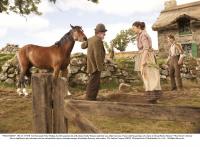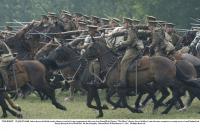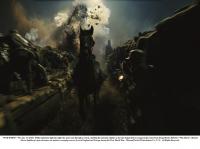Film eye : War Horse
Published in 20th-century / Contemporary History, Issue 2(March/April 2012), Reviews, Volume 20, World War I
The opening half-hour of the film is set in the breathtaking rural idyll of pre-war Devon, where Albert (Jeremy Irvine, right), an earnest farmer’s son, forms a close bond with a thoroughbred horse called Joey.
With some memorable exceptions—Lewis Milestone’s All Quiet on the Western Front and Stanley Kubrick’s searing Paths of Glory being chief among them—Hollywood has shown little interest in the First World War. This is partly because the received narrative of the conflict—military stalemate, futile slaughter and an unsatisfying Allied victory—does not lend itself particularly well to a conventional Hollywood movie script. It also reflects the fact that for the American cinema-going public of the past 50 years the ‘war to end all wars’ has held nothing like the resonance of the American Civil War or World War II. Films focusing on these conflicts, and latterly on Vietnam, have traditionally dominated the American ‘war movie’ market. It was with some interest, then, that historians of the First World War greeted the news that the mayor of dreamland himself was set to give the Western Front the full Hollywood treatment in an adaptation of Michael Morpurgo’s War Horse. The opening half-hour of the film is set in the breathtaking rural idyll of pre-war Devon, where an earnest farmer’s son forms a close bond with a thoroughbred horse called Joey. Everything changes with the advent of war, and the dramatic intensity is heightened as the focus shifts from the moors of southern England to the battlefields of northern France. In a series of skilfully crafted scenes, Spielberg gives us an old-fashioned and often gripping tale of friendship, loyalty, courage and the uneven relationship between animals and men. War Horse is by no means flawless; the characters are all extremely one-dimensional, the plot frequently drifts into ‘Black-Beauty-goes-to-war’ parody and, despite a strong cast, the lacklustre dialogue means that the acting is never all that inspiring. Yet, as with the hugely successful stage production of the book, the film’s remarkably powerful portrayal of equine movement and emotion redeems virtually all of its shortcomings. The cinematography is consistently stunning, and Spielberg’s trademark sentimentality—both his great strength and his great weakness—seem much less out of place here than in Schindler’s List or Saving Private Ryan. In one particularly moving scene the titular hero gets hopelessly entangled in a mess of barbed wire and the director succeeds in saying something genuinely meaningful about the pity of war.

Instances of cavalrymen galloping into enemy positions with swords drawn were neither as rare nor as suicidal as one might suppose.
So, in cinematic terms, War Horse works. But what about its historical content? For the most part, scholars of the period will have little grounds for complaint. Front-line fire trenches were rarely as wide and roomy as they are in the film. And because they were traversed in order to localise the effects of shell blast and to prevent enfilading fire, they never ran in a straight line. It would therefore have been virtually impossible for a horse to go charging into one at speed, as Joey does in one scene. Also, although the Germans were quite prepared to summarily execute French and Belgian civilians, they were rather more compassionate than the British in their treatment of deserters. These are pretty minor quibbles, however, and the film actually paints a surprisingly accurate picture of the role played by horses during the First World War. Instances of cavalrymen galloping into enemy positions with swords drawn were neither as rare nor as suicidal as one might suppose. But barbed wire, machine-guns, poison gas and, not least, a landscape pulverised by shellfire made the cavalry charge all but redundant on the Western Front. During the opening months of the conflict, cavalry horses made up about 34% of the equine strength of the British Expeditionary Force. By 1918 this figure had fallen to less than 2%, and the overwhelming majority of horses were serving as beasts of burden hauling artillery pieces, supply wagons and ambulances. An estimated 250,000 British (including Irish), French and German horses died on the Western Front, but few of these were charging at the enemy when they were killed and many were simply worked to death. Joey’s ephemeral presence in different parts of the line captures much of the complexity of this story and reminds us just how much the war effort in France and Belgium relied on the sweat and sinew of horses. A scene in which he gets cornered by a tank works particularly well, and emphasises the vulnerability of the horse in the age of mechanised warfare.

Front-line fire trenches were rarely as wide and roomy as this German one. It would have been virtually impossible for a horse to go charging into one at speed, as Joey does here. (All images: David Appelby/Dreamworks)
Many readers will have tuned in to the recent BBC adaption of Sebastian Faulk’s Birdsong. On the face of it, this elegantly directed mini-drama could not be more different to War Horse. The TV series, directed by Martin Philip and written by Abi Morgan, focuses on an English officer who is haunted by memories of a pre-war affair with a French woman. It deals with decidedly grown-up themes, the characters are skilfully and slowly developed, the acting is generally excellent, and much of the emphasis is on mood and tone. Spielberg’s film, by contrast, is a visually spectacular Boy’s Own story. Yet both successfully tackle the emotional experience of the First World War and both will no doubt increase popular interest in the conflict. And as we move ever closer to 2014 and the centenary of the outbreak of the war, increased awareness of the roles played by different groups on the Western Front, be it beleaguered war horses or the subterranean sappers of Birdsong, can only be a good thing. Spielberg has referred to War Horse as his ‘first truly British film’, but the narrative deals with universal themes and Irish people will find much of interest in this flawed but compelling piece of cinema. HI
Edward Madigan is resident historian with the Commonwealth War Graves Commission.
















